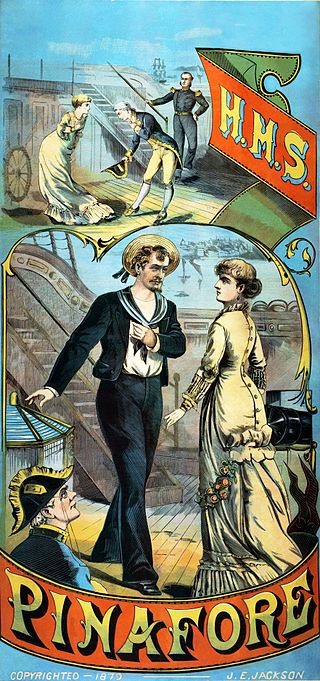
H.M.S. Pinafore; or, The Lass That Loved a Sailor is a comic opera in two acts, with music by Arthur Sullivan and a libretto by W. S. Gilbert. It opened at the Opera Comique in London, on 25 May 1878 and ran for 571 performances, which was the second-longest run of any musical theatre piece up to that time. H.M.S. Pinafore was Gilbert and Sullivan's fourth operatic collaboration and their first international sensation.

Savoy opera was a style of comic opera that developed in Victorian England in the late 19th century, with W. S. Gilbert and Arthur Sullivan as the original and most successful practitioners. The name is derived from the Savoy Theatre, which impresario Richard D'Oyly Carte built to house the Gilbert and Sullivan pieces, and later those by other composer–librettist teams. The great bulk of the non-G&S Savoy Operas either failed to achieve a foothold in the standard repertory, or have faded over the years, leaving the term "Savoy Opera" as practically synonymous with Gilbert and Sullivan. The Savoy operas were seminal influences on the creation of the modern musical.

The Sorcerer is a two-act comic opera, with a libretto by W. S. Gilbert and music by Arthur Sullivan. It was the British duo's third operatic collaboration. The plot of The Sorcerer is based on a Christmas story, An Elixir of Love, that Gilbert wrote for The Graphic magazine in 1876. A young man, Alexis, is obsessed with the idea of love levelling all ranks and social distinctions. To promote his beliefs, he invites the proprietor of J. W. Wells & Co., Family Sorcerers, to brew a love potion. This causes everyone in the village to fall in love with the first person they see and results in the pairing of comically mismatched couples. In the end, Wells must sacrifice his life to break the spell.
The patter song is characterised by a moderately fast to very fast tempo with a rapid succession of rhythmic patterns in which each syllable of text corresponds to one note. It is a staple of comic opera, especially Gilbert and Sullivan, but it has also been used in musical theatre and elsewhere.

The Bab Ballads is a collection of light verse by W. S. Gilbert (1836–1911), illustrated with his own comic drawings. The poems take their name from Gilbert’s childhood nickname. He later began to sign his illustrations "Bab". In writing these verses Gilbert developed his "topsy-turvy" style in which the humour is derived by setting up a ridiculous premise and working out its logical consequences, however absurd. The ballads also reveal Gilbert's cynical and satirical approach to humour. Gilbert wrote most of the "ballads", and first published a collection of them in book form, before he became famous for his comic opera librettos written in collaboration with the composer Arthur Sullivan.

Thomas German Reed, known after 1844 as simply German Reed was an English composer, musical director, actor, singer and theatrical manager of the Victorian era. He was best known for creating the German Reed Entertainments, together with his actress wife, a genre of musical plays that made theatre-going respectable at a time when the stage was considered disreputable.

Ages Ago, sometimes stylised as Ages Ago! or Ages Ago!!, is a musical entertainment with a libretto by W. S. Gilbert and music by Frederic Clay that premiered on 22 November 1869 at the Royal Gallery of Illustration. It marked the beginning of a seven-year collaboration between Gilbert and Clay. The piece was a critical and popular success and was revived many times, including at St. George's Hall, London in 1870 and 1874, and in New York in 1880.
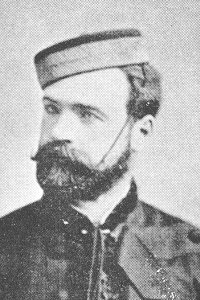
Hugh Talbot, born Hugo Talbot Brennan, was an Irish tenor best known for creating, to universally bad reviews, the role of Frederic in the Gilbert and Sullivan hit The Pirates of Penzance in the original New York production.
This is a selected list of W. S. Gilbert's works, including all that have their own Wikipedia articles. For a complete list of Gilbert's dramatic works, see List of W. S. Gilbert dramatic works.
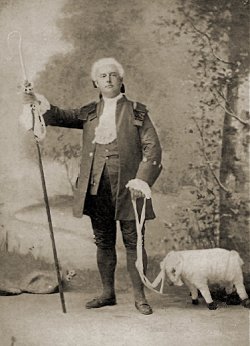
Happy Arcadia is a musical entertainment with a libretto by W. S. Gilbert and music originally by Frederic Clay that premiered on 28 October 1872 at the Royal Gallery of Illustration. It was one of four collaborations between Gilbert and Clay between 1869 and 1876. The music is lost. The piece is a satire on the genre of pastoral plays in which the characters, who each wish that they could be someone else, have their wish granted, with unhappy results.

Foggerty's Fairy and Other Tales is an 1890 book by W. S. Gilbert, collecting several of the short stories and essays he wrote in his early career as a magazine writer. A number of them were later adapted as plays or opera librettos.

Topsyturveydom is a one-act operetta by W. S. Gilbert with music by Alfred Cellier. Styled "an entirely original musical extravaganza", it is based on one of Gilbert's Bab Ballads, "My Dream". It opened on 21 March 1874 at the Criterion Theatre in London and ran until 17 April, for about 25 performances. This was the first work shown at the newly built Criterion, and it was played together with An American Lady, written and performed by Gilbert's friend, the dramatist and Fun magazine founder, Henry J. Byron. The musical score to Topsyturveydom does not survive, but amateur productions in recent decades have used newly composed scores or performed the work as a non-musical play.

Sir William Schwenck Gilbert was an English dramatist, librettist, poet and illustrator best known for his collaboration with composer Arthur Sullivan, which produced fourteen comic operas. The most famous of these include H.M.S. Pinafore, The Pirates of Penzance and one of the most frequently performed works in the history of musical theatre, The Mikado. The popularity of these works was supported for over a century by year-round performances of them, in Britain and abroad, by the repertory company that Gilbert, Sullivan and their producer Richard D'Oyly Carte founded, the D'Oyly Carte Opera Company. These Savoy operas are still frequently performed in the English-speaking world and beyond.

Dan'l Druce, Blacksmith is a play by W. S. Gilbert, styled "A Three-Act Drama of Puritan times". It opened at the Haymarket Theatre in London on 11 September 1876, starring Hermann Vezin, Johnston Forbes-Robertson and Marion Terry. The play was a success, running for about 100 performances and enjoying tours and several revivals. It was popular enough to be burlesqued in a contemporary work, Dan'l Tra-Duced, Tinker, at the Strand Theatre. In an 1894 revival, Nancy McIntosh played Dorothy.

Robert the Devil, or The Nun, the Dun, and the Son of a Gun is an operatic parody by W. S. Gilbert of Giacomo Meyerbeer's grand opera Robert le diable, which was named after, but bears little resemblance to, the medieval French legend of the same name. Gilbert set new lyrics to tunes by Meyerbeer, Bellini, Offenbach and others.
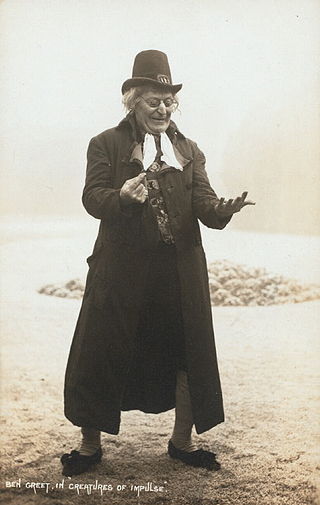
Creatures of Impulse is a stage play by the English dramatist W. S. Gilbert, with music by the composer-conductor Alberto Randegger, which Gilbert adapted from his own short story. Both the play and the short story concern an unwanted and ill-tempered old fairy who enchants people to behave in a manner opposite to their natures, with farcical results.
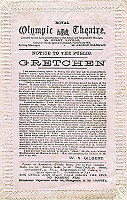
Gretchen is a tragic four-act play, in blank verse, written by W. S. Gilbert in 1878–79 based on Goethe's version of part of the Faust legend.

The Fortune Hunter is a drama in three acts by W. S. Gilbert. The piece concerns an heiress who loses her fortune. Her shallow husband sues to annul the marriage, leaving her pregnant and taking up with a wealthy former lover. The piece was produced on tour in Britain in 1897, never playing in London.

Trial by Jury is a comic opera in one act, with music by Arthur Sullivan and libretto by W. S. Gilbert. It was first produced on 25 March 1875, at London's Royalty Theatre, where it initially ran for 131 performances and was considered a hit, receiving critical praise and outrunning its popular companion piece, Jacques Offenbach's La Périchole. The story concerns a "breach of promise of marriage" lawsuit in which the judge and legal system are the objects of lighthearted satire. Gilbert based the libretto of Trial by Jury on an operetta parody that he had written in 1868.
















